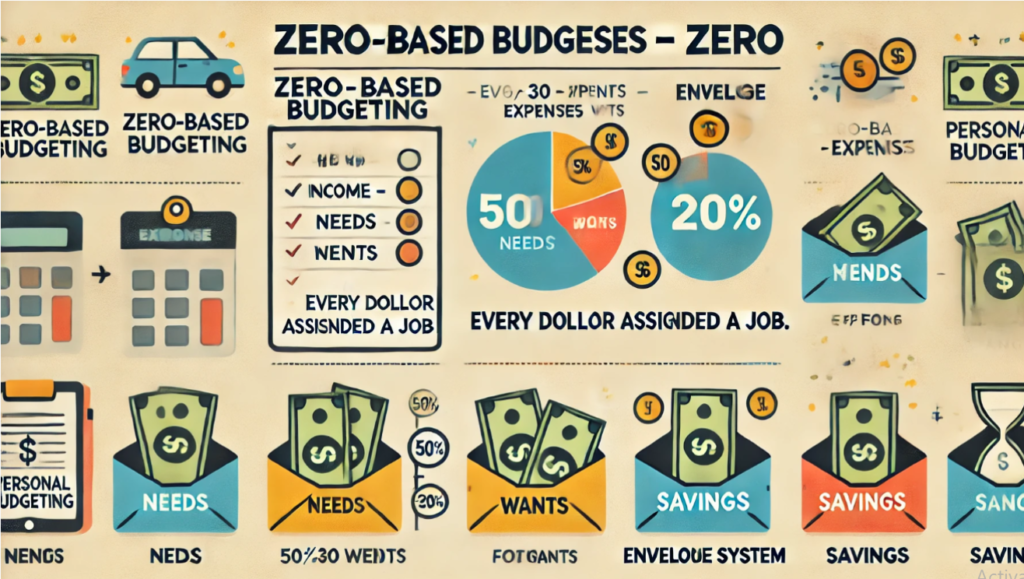
Did you know that the average American overspends by hundreds of dollars each month? With the cost of living on the rise and inflation affecting our economy, it has become more important budget hacks for saving money. Budgeting is not just about cutting back on expenses, but it is also about making sure that our hard-earned money is being put to good use. In this article, we will discuss the importance of budgeting in today’s economy and provide practical strategies for saving money. By understanding where our money is going and making conscious decisions about our spending, we can better prepare for the future and avoid unnecessary financial stress.
Understand Your Financial Situation
Track Your Spending:

It’s really important to have a good understanding of where your money is going each month. Tracking your spending can help you identify areas where you may be overspending and find ways to save money. There are several tools available to help you easily track your daily expenses, such as budgeting apps or simple spreadsheets. These tools can give you a clear picture of your financial habits and help you make better decisions about your money. By knowing where your money is going, you can take control of your finances and work towards your financial goals.
Assessing Income vs. Expenses:

To create a simple budget using the 50/30/20 rule or a similar model, you first need to assess your income and expenses. Start by calculating your total monthly income, including your salary, bonuses, and any other sources of income. Then, list out all of your monthly expenses, including necessities like rent or mortgage, utilities, groceries, and transportation, as well as discretionary spending on things like dining out and entertainment. Once you have a clear picture of your income and expenses, you can allocate your funds according to the 50/30/20 rule. This rule suggests that 50% of your income should go towards necessities, 30% towards discretionary spending, and 20% towards savings and debt repayment.
Identify Areas to Cut Back:

Sure, identifying areas to cut back on is a great way to save money. Some common areas where people overspend without realizing it include subscriptions such as streaming services, magazine subscriptions, or gym memberships that aren’t being used. Eating out can also add up quickly, so it’s a good idea to limit how often you dine out or order takeout. And impulse buying, whether it’s clothes, gadgets, or other non-essential items, can also contribute to overspending. By being mindful of these areas, you can make small changes that can add up to big savings over time.
Cut Unnecessary Subscriptions
Regularly reviewing and auditing your subscriptions is important for managing your finances and ensuring you are getting the most value out of your monthly expenses. Subscriptions to streaming services, magazines, and apps can add up quickly, and it’s easy to overlook the total cost when they are billed individually. When deciding what subscriptions to cancel or downgrade, it’s helpful to consider consolidating services. For example, instead of paying for multiple streaming services individually, consider combining them into a single package. This can help save money and simplify your entertainment options. Additionally, it’s worth exploring alternative solutions, such as sharing family plans with friends or family members. Many streaming services offer family or group plans that allow multiple users to access the content at a reduced cost.
Meal Planning and Cooking at Home

Meal planning is a great way to save time and money when it comes to cooking at home. By creating a meal plan for the week, you can reduce your grocery costs by only purchasing the items you need for specific meals. This also helps to minimize impulse buys and unnecessary spending. A simple structure for meal prepping could include choosing a few different recipes for the week, making a list of the ingredients needed, and then setting aside time to prepare and cook these meals in advance. This way, you can have ready-made meals for the week, saving time and reducing the temptation to eat out. Another helpful strategy for meal planning and cooking at home is batch cooking.
Reduce Utility Bills

Reducing utility bills can be achieved through a variety of simple and cost-effective strategies. One of the most effective ways to lower electricity and water bills is by adopting energy-efficient habits. This can be as simple as turning off lights and appliances when they are not in use, reducing the temperature of your water heater, and being mindful of water usage. Another way to potentially save on utility bills is by exploring different providers for electricity, gas, or internet services. By shopping around and comparing prices, you may be able to find a better deal and lower your monthly expenses. Investing in smart technology can also help you reduce utility costs.
Save on Transportation

Using public transportation or carpooling can significantly reduce transportation costs in several ways. First, by sharing a ride with others, you can split the cost of fuel and parking, saving you money on a daily basis. Additionally, carpooling reduces wear and tear on your vehicle, which can lead to lower maintenance costs in the long run. Public transportation, on the other hand, eliminates the need for owning and maintaining a personal vehicle altogether, saving on fuel, insurance, and maintenance expenses. In addition to carpooling and public transportation, there are several ways to save on fuel and vehicle maintenance. Keeping your tires properly inflated can improve fuel efficiency, while regular tune-ups and maintenance can prevent costly repairs down the road.
Shop Smart

Shopping smart means being strategic about when and how you make your purchases. One way to save money is to take advantage of sales events such as Black Friday or end-of-season clearances. By timing your purchases around these events, you can score big discounts on items you need. Another way to save is by using coupons and cashback apps. There are a variety of websites, apps, and loyalty programs that offer discounts and cashback on everyday purchases. By taking advantage of these offers, you can save money on things like groceries, clothing, and household items. Consider buying secondhand or discounted items.
Save on Entertainment and Leisure

When it comes to saving on entertainment and leisure activities, there are several options to consider. One way to save money is by participating in low-cost or free activities. This can include exploring free local events, taking part in nature activities such as hiking or birdwatching, or getting involved in community programs. These options provide a great way to have fun without breaking the bank. Another way to save on entertainment is by seeking out cheaper or free alternatives to mainstream streaming services. Platforms like YouTube offer a wide range of content at no cost, while public libraries often provide access to movies, TV shows, and music for free or at a low cost. For those looking for hands-on, budget-friendly fun, DIY activities can be a great option.
Build an Emergency Fund

Why It’s Important:
It’s important to have an emergency fund because it can save you money in the long run by avoiding high-interest debt. When unexpected expenses arise, such as car repairs or medical bills, having money set aside in an emergency fund allows you to cover these costs without having to rely on credit cards or loans with high interest rates. By avoiding high-interest debt, you can save money on interest payments and prevent yourself from falling into a cycle of debt. This can ultimately help you maintain financial stability and reach your long-term financial goals.
How to Start Small:
To start small, consider setting up an automatic transfer from your checking account to a savings account. Even a small amount transferred regularly can add up over time. Start by determining a realistic amount that you can comfortably transfer each month. Then, set up an automatic transfer through your bank’s online portal or mobile app. As you become more comfortable with the process, you can gradually increase the amount transferred to build your savings fund even further. This can be a great way to start saving and to develop a consistent savings habit.
Saving for Large Expenses:
When it comes to planning for large expenses like vacations or car repairs, it’s important to have a dedicated savings goal in mind. By setting aside a portion of your income specifically for these expenses, you can ensure that you have the funds available when the time comes. This could involve creating a separate savings account or using a budgeting tool to track your progress. By planning ahead and consistently saving, you can avoid the stress of having to come up with a large sum of money all at once. It’s a smart way to prepare for future expenses and stay on top of your financial goals.

In conclusion, the key strategies discussed in the article include the importance of creating a budget, prioritizing needs over wants, reducing unnecessary expenses, and increasing savings through automated transfers. These strategies are essential for anyone looking to improve their financial situation and build long-term wealth. It’s important to take immediate action by starting with one or two hacks that are easiest for you to implement. This could include tracking your expenses for a month to identify areas where you can reduce spending, setting up automated transfers to a savings account, or creating a budget to better manage your finances. By taking these initial steps, you can begin to see positive changes in your financial situation. In conclusion, it’s important to remember that small changes over time can lead to significant savings.













